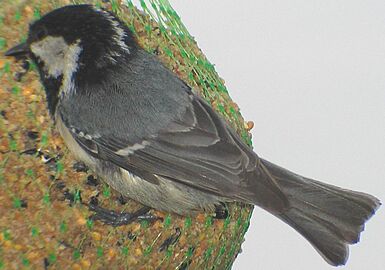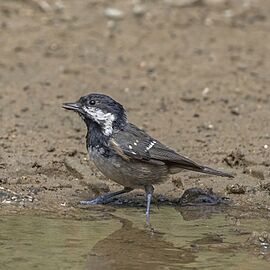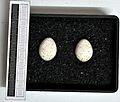Coal tit facts for kids
The coal tit (Periparus ater) is a small bird that belongs to the tit family, Paridae. These birds are known as passerines, which means they are perching birds. Coal tits are very common and live in forests across a large area called the Palearctic. This area includes places with mild weather (temperate) and warmer areas (subtropical), even parts of North Africa. The black-crested tit is now usually considered the same species as the coal tit.
Quick facts for kids Coal tit |
|
|---|---|
 |
|
| Adult British coal tit, P. a. britannicus (note greenish-grey back) |
|
| Conservation status | |
| Scientific classification | |
| Genus: |
Periparus
|
| Species: |
ater
|
 |
|
| Range of P. ater Resident Non-breeding | |
| Synonyms | |
|
Parus ater Linnaeus, 1758 |
|
Contents
About the Coal Tit's Name
The coal tit was first described by a famous scientist named Carl Linnaeus in 1758. He gave it the scientific name Parus ater. The word ater is Latin for "dull black," which describes the bird's dark head.
Over time, the names for birds can change. For example, in German, the coal tit used to be called Kohlmeiß, which means "coal tit." But now, that name refers to the great tit (Parus major). Today, the coal tit is called Tannenmeise in German, which means "fir tit," because it often lives in fir forests.
Scientists sometimes study how different types of birds are related. The coal tit is very similar to the spot-winged tit from South Asia. They look alike, and sometimes they even have babies together. Scientists use DNA to figure out if they are truly separate species or if they should be considered the same.
Different Kinds of Coal Tits
There are many different types, or subspecies, of coal tits. They can look quite different in color, but their sizes are usually similar.
- The British coal tit (P. a. britannicus) has a brownish-grey back with a hint of olive green.
- The coal tits in mainland Europe (like P. a. ater) have a bluish-grey back with no green or brown.
- The Irish coal tit (P. a. hibernicus) has pale yellow cheeks, chest, and belly. It also has a lighter rump and a bigger beak.
- In North Africa, the coal tit (P. a. ledouci) has yellow underparts and cheeks.
- The Cypriot coal tit (P. a. cypriotes) from Cyprus has a light brown color on its upper parts and deep buff underparts.
- Asian coal tits, like those from the Himalayas, are generally darker and brownish.
What Does a Coal Tit Look Like?
A coal tit is a small bird, about 10–11.5 cm long. It has a very clear white spot on the back of its black head. Its head, throat, and neck are shiny blue-black. The sides of its face are off-white, sometimes with a grey or yellow tint depending on the subspecies.
It has two white stripes on its wings. Its belly is whitish, changing to a buff or reddish-brown color on its sides. The beak is black, the legs are grey, and its eyes are dark brown.
Young coal tits look a bit duller than adults. Their black heads are not as shiny, and the white parts on their nape and cheeks have a yellow tint.
Coal Tit Sounds and Songs
When coal tits are looking for food in groups, they make short "dee" or "see-see" calls to stay in touch. Their song sounds like a loud "if-he, if-he, if-he." You can hear this song most often from January to June, and sometimes in autumn. It's similar to the song of the great tit, but much faster and higher pitched. Some coal tits end their song with a sharp "ichi."
Where Coal Tits Live and What They Do
Coal tits usually live in conifer forests, which are forests with trees like pines and firs. They are found in many different types of forests. For example, in Bhutan, they live in forests with fir trees and rhododendrons, high up in the mountains.
Most coal tits stay in the same area all year round. They only move to new places if the weather gets very bad. However, coal tits from Siberia often migrate, or travel, to warmer places for the winter.
In winter, coal tits often join small groups with other types of tits. They are very active and good at climbing, just like other tits. They can cling to tree trunks and hop around like a treecreeper.
Their diet is similar to other tits. They love beechmast (seeds from beech trees) and pick seeds from fir and larch cones. They also eat seeds from alder and birch trees. You might even see them in gardens, eating sunflower seeds from bird feeders.
Scientists have studied how coal tits find food. They found that coal tits will look for food in different places if they don't have enough energy. They also gain more weight in the evening if they hear calls from tawny owls, which might be a sign of danger.
Coal tits are very common and found in many places, so they are not considered an endangered species.
Reproduction and Life Cycle
Coal tits like to build their nests in holes in rotting tree stumps, often close to the ground. They also use holes in the ground, burrows made by mice or rabbits, cracks in walls, or old nests of other large birds like magpies.
They build their nests using moss, hair, and grass, making it very soft. They line the nest with rabbit fur or feathers. Female coal tits usually lay seven to eleven white eggs with red spots. This usually happens in May. Coal tits typically breed once a year.
Images for kids
-
The colourful great tit (Parus major) with its bold wing-stripe.
See also








